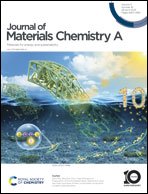Defect-enrichment in porous interface of ultrathin CuO nanobelts realizes a novel CO2 photoreduction pathway†
Abstract
Selective photocatalytic conversion of CO2 into liquid fuels via single component metal oxides represents an attractive strategy to achieve carbon balance and mitigate global warming. Herein, we for the first time propose that the integration of porous channel confinement and oxygen vacancy (VO) for synergistically regulating the generation of key intermediates, enables highly selective CO2 reduction and the controllable switches of specific CH3OH or CO reaction pathways. In situ photoelectric characterization and theoretical calculations ensure that the versatile porous structure endows ultrathin CuO with an enrichment of catalytic sites coverage, improved adsorption microenvironment, and a short charge transport distance, assuring the excellent mass-transport and binding capability of reactants. This helps to facilitate inert CO2 into a key reactive intermediate. Furthermore, the VO near the porous interface, which is an actual catalytic site can regulate the formation energy of key intermediates for CO2 activation, so that the adsorbed *CO can selectively generate a thermodynamically favorable *CHO intermediate with the corresponding Gibbs free energy change value being −0.09 eV (vs. 1.86 eV of perfect CuO), thus triggering a distinctive CH3OH reaction pathway, rather than desorption, to release CO. Benefiting from these merits, the optimal CuO with a precise design enables the effective CO2 photoreduction into value-added CH3OH at an evolution rate of 12.3 μmol g−1 h−1, a selectivity of 62.5%, and more importantly, a robust durability is realized, which is superior to most of the previously reported photocatalysts until now. This work sheds light on the fact that defect-enrichment in a porous interface can customize the unique reaction pathway for the CO2 photoreduction to liquid fuels and offers a novel insight for the design of cheap and effective CO2 photocatalysts.

- This article is part of the themed collection: 1D/2D materials for energy, medicine, and devices


 Please wait while we load your content...
Please wait while we load your content...